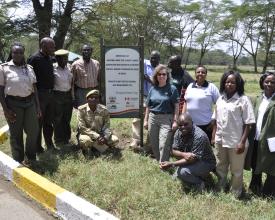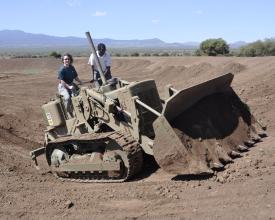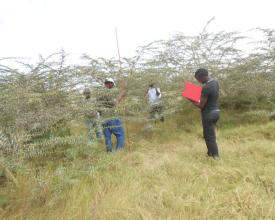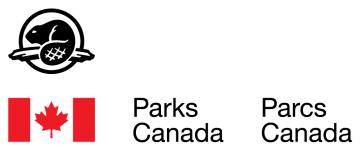
Los organismos responsables de los parques colaboran para hacer frente de forma integral a los efectos del cambio climático
Solución completa
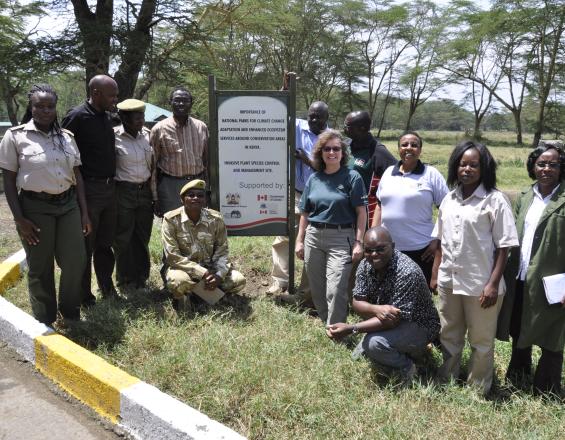
Equipo de ejecución del proyecto en el PN del Lago Nakuru
En el marco de una asociación de colaboración entre el Kenya Wildlife Service (KWS) y Parks Canada, se llevaron a cabo intervenciones para mejorar la capacidad de adaptación de seis parques nacionales y las comunidades locales adyacentes a los efectos del cambio climático. Las iniciativas se centraron en la restauración ecológica de hábitats degradados, la gestión de especies invasoras, la mejora del suministro de agua para las personas y la fauna durante las estaciones secas, y la capacitación del personal del KWS y las comunidades locales.
Última actualización: 06 Feb 2023
5105 Vistas
Contexto
Défis à relever
degradación de los ecosistemas, pérdida de biodiversidad e intensos conflictos entre el hombre y la fauna silvestre Los efectos combinados de sequías prolongadas, menor disponibilidad de agua, alta concentración de animales en unos pocos lugares con agua permanente y una propagación sin precedentes de especies invasoras en hábitats privilegiados de los parques nacionales han provocado una grave y generalizada degradación de los ecosistemas, pérdida de biodiversidad, escaso atractivo turístico e intensos conflictos entre el hombre y la fauna silvestre.
Ubicación
Kenia
África Oriente y África del Sur
Procesar
Resumen del proceso
El objetivo del proyecto era mejorar la adaptación de los ecosistemas y las comunidades al cambio climático. La asociación de colaboración ayudó a crear una visión común, acordar el diseño del proyecto y el marco de ejecución, identificar las necesidades de capacidad y definir funciones y responsabilidades. Gracias a la colaboración y al desarrollo de capacidades, fue posible recaudar fondos y aprovechar las diversas competencias necesarias para poner en marcha amplias intervenciones de adaptación en distintas partes del país. La gestión de especies invasoras y la restauración ecológica de hábitats críticos fueron cruciales para minimizar el estrés ambiental, mejorar la integridad ecológica y aumentar la resiliencia de los ecosistemas a los impactos del cambio climático. La protección de las fuentes de agua y la mejora de la disponibilidad de agua durante los periodos de escasez aumentaron el valor de las zonas protegidas, mejoraron las relaciones entre los parques y las comunidades vecinas y redujeron los conflictos entre el hombre y la fauna. La reducción de los conflictos también contribuyó a crear asociaciones significativas para la restauración ecológica y otras estrategias de adaptación al cambio climático.
Bloques de construcción
Participación de diversos socios para hacer frente a los efectos del cambio climático
La creación de una sólida asociación de colaboración fue un importante factor de éxito para este proyecto. En un taller de planificación de la gestión celebrado en julio de 2011, al que asistieron científicos, planificadores y gestores del KWS y facilitado por Parks Canada, se identificó el cambio climático como el reto de conservación más importante al que se enfrentan los parques nacionales de Kenia. Se identificaron seis parques muy afectados por el cambio climático para intervenir en su adaptación y se determinaron las iniciativas adecuadas para cada uno de ellos. La estrategia de ejecución del proyecto exigía la participación de diversos socios de los sectores público y privado. El KWS consultó a las comunidades locales, investigadores, ONG, visitantes de los parques, grupos escolares, la industria turística, trabajadores sanitarios y grupos de jóvenes y mujeres asociados a cada parque, les informó del objetivo del proyecto de mejorar la adaptación al cambio climático y les pidió que participaran en su ejecución. El KWS y Parks Canada aportaron apoyo científico y técnico, mientras que otros participantes contribuyeron con sus competencias profesionales, conocimientos locales, trabajo y entusiasmo. El Gobierno de Canadá aportó financiación a través de la Iniciativa Fast Start sobre el Cambio Climático.
Factores facilitadores
- La existencia de un marco nacional sobre el cambio climático en Kenia ayudó a implicar a las partes interesadas en las cuestiones relacionadas con los efectos del cambio climático y la necesidad de una respuesta social. - Un programa de conservación comunitaria sólido y eficaz del KWS facilitó la divulgación. - Una asociación formal entre el KWS y Parks Canada, ejecutada a través de un Memorando de Entendimiento, facilitó la obtención de fondos y brindó la oportunidad de compartir conocimientos profesionales para desarrollar y aplicar intervenciones de adaptación a gran escala.
Lección aprendida
- Dialogar con la gente para concienciarla sobre los impactos del cambio climático en sus medios de subsistencia y el papel que las áreas protegidas pueden desempeñar para hacerles frente puede promover su voluntad de participar en intervenciones de adaptación - Poner en práctica acciones de intervención junto con diversos grupos ayudó a aumentar la concienciación y la comprensión de los impactos del cambio climático, los beneficios de las áreas protegidas y los ecosistemas saludables para hacer frente a las amenazas del cambio climático, y la necesidad de una acción colectiva e individual en la mitigación y la adaptación - Una asociación como la de Parks Canada-KWS puede ser un modelo de colaboración interinstitucional para hacer frente a los desafíos globales
Implicar a los ciudadanos en el control de la propagación de especies invasoras
Las especies invasoras de los parques nacionales de Amboseli, Tsavo y Nakuru habían cubierto grandes extensiones de hábitat silvestre, desplazado la biodiversidad autóctona, reducido el forraje favorable, afectado a la distribución de la fauna y disminuido el disfrute de los visitantes. En cada parque, el personal del KWS trabajó con la población local y otros científicos para identificar las especies invasoras, su impacto en la vida salvaje, las estrategias de detección precoz y los mecanismos de control y erradicación. Se prestó especial atención a las especies que crecían rápidamente, se reproducían con profusión, se dispersaban ampliamente y superaban a las especies autóctonas. Se cartografiaron las zonas más infestadas y se dividieron en bloques para permitir un control sistemático. Se prefirió la eliminación mecánica a la erradicación química para minimizar los riesgos para las especies no objetivo. El KWS organizó grupos de voluntarios de instituciones y comunidades locales para arrancar mecánicamente las plantas invasoras de las zonas designadas. En algunos casos se contrató a lugareños para trabajar en zonas difíciles. La basura arrancada se quemó en canteras abandonadas o se enterró para evitar su reinvasión. Se volvieron a visitar las parcelas durante tres temporadas de crecimiento y se eliminó el rebrote.
Factores facilitadores
- Muchos grupos de ciudadanos se mostraron dispuestos a participar en la erradicación de especies invasoras - Se disponía de abundante mano de obra local para el control mecánico, un método que requiere mucha mano de obra - Existía un buen conocimiento del impacto de las especies invasoras a nivel individual y comunitario - Se disponía de conocimientos tradicionales y de expertos para identificar las especies invasoras y sus impactos - Se disponía de financiación suficiente para adquirir los implementos necesarios, pagar a los trabajadores eventuales cuando fuera necesario y apoyar la logística.
Lección aprendida
- Se observó una reinvasión y la erradicación completa sólo fue posible tras tres sesiones consecutivas de eliminación mecánica que abarcaron varias temporadas de crecimiento.
- Los herbívoros pudieron utilizar inmediatamente las zonas desbrozadas, pero los grandes depredadores se vieron perjudicados, ya que acechar a sus presas era más difícil en zonas más abiertas.
- Entender la causa y el mecanismo de la invasión puede ayudar a erradicar o contener las especies invasoras - Ofrecer entrada gratuita al parque a los voluntarios puede ser un incentivo inicial para que participen en el control de las especies invasoras - Comunicar el éxito y los retos del control de las especies invasoras puede atraer apoyo adicional de las partes interesadas y los donantes.
Restauración de hábitats degradados
La restauración de hábitats degradados tenía como objetivo mejorar la resistencia de los ecosistemas en cinco parques nacionales clave que, en conjunto, proporcionan servicios ecosistémicos a más de la mitad de la población de Kenia y figuran entre los diez principales destinos turísticos del país. La restauración se centró en zonas ya designadas para la rehabilitación en los planes de gestión de los parques. Se cercaron bloques de aproximadamente 100 hectáreas en zonas degradadas con vallas eléctricas alimentadas con energía solar para excluir a la fauna salvaje y permitir la regeneración. La estructura y el diseño de las vallas se basaron en las condiciones específicas del lugar y en el nivel de riesgo de daños por grandes herbívoros. El KWS, las comunidades locales o el Instituto de Investigación Forestal de Kenia (KEFRI) proporcionaron plantones de especies autóctonas que se plantaron en los cercados para complementar la regeneración natural. Se creó al menos un vivero moderno en cada parque y, en la medida de lo posible, en las zonas comunitarias vecinas para mantener un suministro de plántulas a largo plazo. Se colocaron carteles interpretativos en los lugares restaurados para informar al público. Se ampliaron las pistas de avistamiento de animales a algunas de estas zonas para mostrar los beneficios de la restauración.
Factores facilitadores
- Los resultados de varios experimentos de restauración ecológica estaban disponibles en las zonas del proyecto - Se disponía de financiación para la formación, la adquisición de las instalaciones necesarias y el apoyo a la gestión del proyecto - Se contaba con diversos expertos para llevar a cabo tareas especializadas - Las comunidades y los diversos sectores de la sociedad, incluido el sector privado, estaban dispuestos a participar en la restauración ecológica - El KWS pudo llegar a diversos grupos comunitarios y ciudadanos e implicarlos
Lección aprendida
- Es mucho más fácil conseguir apoyo para la restauración ecológica cuando se comprenden bien las causas de la degradación y se incorpora la necesidad de intervención en los planes de gestión de los parques nacionales - La restauración ecológica puede ser una empresa costosa que requiere planificación, diversos recursos y conocimientos especializados durante periodos prolongados - Algunos métodos de restauración, como los que utilizan vallas eléctricas, pueden requerir formación especializada para el mantenimiento posterior al proyecto - Participar en la restauración ecológica puede brindar a la gente la oportunidad de experimentar y conectar con la naturaleza y descubrir los numerosos beneficios de las áreas protegidas.
- Las comunidades pueden aportar conocimientos especializados, recursos, mano de obra gratuita y otros tipos de apoyo si se les informa de los beneficios de la restauración ecológica.
Aumentar la disponibilidad de agua para reducir los conflictos
La fauna salvaje de los parques nacionales de Amboseli y Tsavo invade las tierras comunitarias durante los periodos de sequía en busca de agua, mientras que la gente lleva su ganado a los parques en busca de pastos. Estos movimientos inversos de la fauna salvaje y el ganado suelen dar lugar a intensos conflictos entre los humanos y la fauna salvaje. El proyecto se centró en la creación de depósitos de agua en parques y zonas comunitarias que pudieran conservar el agua de lluvia durante 4-6 meses en la estación seca, lo que permitiría a la fauna salvaje y al ganado utilizar diferentes partes del paisaje durante periodos más largos y reduciría la necesidad de que la fauna salvaje y el ganado cruzaran los límites de los parques. Se identificaron zonas adecuadas para captar el agua de lluvia y se excavaron presas y balsas de agua. Se rehabilitaron algunas presas antiguas que se alimentaban de arroyos y ríos que se habían secado. Además, se identificaron importantes pantanos que proporcionan agua a la fauna y a las comunidades durante todo el año y se vallaron para reducir la degradación debida al uso excesivo. El agua se bombeó a abrevaderos construidos fuera de la valla para garantizar un suministro sostenido a las personas, el ganado y la fauna. Se plantaron árboles a lo largo de los pantanos para reducir la erosión del suelo.
Factores facilitadores
- Se dispuso de financiación para acometer excavaciones relativamente costosas - El KWS y las comunidades conocen bien la hidrología del terreno - El coste de creación de presas se redujo significativamente, ya que el KWS dispone de conocimientos técnicos, equipos adecuados y experiencia para acometer las tareas - Buen apoyo de la comunidad y de las partes interesadas
Lección aprendida
- Con el cambio climático, puede ser necesario que las comunidades y los organismos encargados de los parques se pongan de acuerdo sobre mecanismos para compartir los recursos hídricos en épocas de escasez con el fin de evitar conflictos entre los seres humanos y la fauna salvaje - Las soluciones medioambientales localizadas, como la protección de los pantanos, pueden reportar enormes beneficios a muchas personas y evitar conflictos entre los seres humanos y la fauna salvaje a diferentes escalas geográficas.
- La recogida de agua de lluvia puede ser una estrategia de bajo coste que puede minimizar los conflictos relacionados con el agua.
- Las estrategias de adaptación que mejoran la prestación de servicios ecosistémicos al tiempo que reducen los conflictos por el uso de los recursos pueden atraer el apoyo de diversos socios.
Formación formal e informal para la adaptación
Dado que la gente no puede adaptarse al cambio climático sin tener antes la capacidad para hacerlo, el proyecto pretendía dotar a un amplio abanico de socios de los conocimientos y aptitudes necesarios para una aplicación eficaz de las medidas de adaptación. Los principales grupos destinatarios eran el personal del KWS y las comunidades locales. Las áreas específicas de formación incluían métodos y técnicas de restauración ecológica, gestión de viveros modernos, incluida la producción y propagación de plántulas. Otros eran técnicas de reforestación, identificación, control y gestión de especies invasoras, control de la calidad y cantidad de agua y mantenimiento de vallas. La formación se impartió a nivel individual, institucional y comunitario y se realizó a través de instituciones formales o mediante formación en el puesto de trabajo. El Instituto de Investigación Forestal de Kenia (KEFRI) impartió formación especializada al KWS y a grupos comunitarios en materia de establecimiento y gestión de viveros de árboles, reforestación y gestión de especies invasoras. La mayoría de los grupos de voluntarios recibieron formación sobre el terreno del personal del KWS y de otros profesionales y técnicos pertinentes.
Factores facilitadores
- Apoyo de grupos comunitarios organizados, como asociaciones forestales comunitarias, grupos turísticos e instituciones de enseñanza.
Lección aprendida
- Las necesidades de capacidad (en términos de competencias) pueden variar de un lugar a otro debido a las diferencias en los impactos del cambio climático y las diferencias en las intervenciones específicas de cada lugar - Responder a los impactos del cambio climático requiere una gran diversidad de competencias y recursos que residen fuera de las agencias de conservación y que pueden aprovecharse a través de colaboraciones y asociaciones.
- Las competencias obtenidas a través de la formación son transferibles a otros ámbitos de la actividad humana.
Impactos
La protección de las fuentes de agua y la provisión de más puntos de agua en parques nacionales y zonas comunitarias aumentaron la disponibilidad de agua para las personas y la fauna salvaje, redujeron los conflictos entre humanos y fauna salvaje y minimizaron la erosión del suelo. El agua de lluvia captada en los embalses está ahora disponible para las personas, la fauna salvaje y el ganado entre 4 y 6 meses después de la estación seca, lo que reduce la necesidad de que la fauna salvaje se desplace fuera de los parques a tierras comunitarias en busca de agua. La eliminación de especies invasoras ha minimizado la pérdida de biodiversidad, ha proporcionado un hábitat más adecuado para la fauna salvaje y ha reducido los conflictos causados cuando ésta se aventura fuera de los parques en busca de mejores pastos. Además, las zonas despejadas de especies invasoras atraen inmediatamente a los pastores y mejoran las oportunidades de observación de la fauna para los visitantes. Las zonas restauradas ecológicamente están mostrando una enorme recuperación y, con el tiempo, proporcionarán mejores hábitats para la fauna silvestre y un mayor suministro de servicios ecosistémicos. Por último, el desarrollo de capacidades permitió una ejecución más eficaz de los proyectos, mientras que una asociación de colaboración ayudó a poner en común recursos, conocimientos, experiencias, aptitudes e influencia para una amplia ejecución de las medidas de adaptación.
Beneficiarios
Servicio de fauna salvaje de Kenia, comunidades agrícolas, industria turística, industria ganadera, empresas generadoras de energía hidroeléctrica y consumidores de agua en algunas zonas rurales y urbanas como Nairobi y Mombasa.
Historia
En los últimos diez años, la vegetación natural del manantial de Mzima, en el PN de Tsavo, se ha ido degradando progresivamente a causa de los elefantes y otros animales salvajes que se concentran por millares en el lugar durante las sequías prolongadas. Además de proporcionar sustento vital a la fauna salvaje, los manantiales también suministran más de 300 millones de litros de agua diarios a unos 3 millones de comunidades situadas río abajo, incluida la segunda ciudad más grande de Kenia, Mombasa. La intervención más urgente fue detener la degradación del hábitat acordonando unas 100 hectáreas del nacimiento de los manantiales con una valla eléctrica de alto voltaje alimentada por energía solar. La valla se diseñó para permitir la entrada y salida de los hipopótamos que viven en los manantiales, al tiempo que se retenía a otros grandes mamíferos. Se puso agua a disposición de la fauna varios cientos de metros río abajo y se bombeó más agua a abrevaderos artificiales construidos fuera del cercado para disuadir a los elefantes de romper la valla. El KWS involucró a turistas, escuelas, comunidades locales, responsables de la toma de decisiones y líderes políticos en la plantación de plantones de árboles para acelerar el proceso de restauración y reducir la erosión del suelo. Estas actividades ayudaron a crear una conciencia significativa sobre el estado de los manantiales, situación que atrajo el interés de los medios de comunicación. El ministro keniata de Desarrollo Hídrico, el gobernador del condado de Taita Taveta y miembros del Parlamento se interesaron por los manantiales y subrayaron públicamente su importancia para impulsar la economía local y nacional, y para reducir los conflictos entre el hombre y la fauna. Tanto el gobierno local como el nacional han puesto en marcha proyectos multimillonarios de desarrollo hídrico para mejorar el suministro de agua a muchas comunidades locales y urbanas. Aunque los manantiales no habían sido apreciados como una fuente importante de agua desde 1953, cuando el gobierno colonial construyó las obras hidráulicas, el proyecto ayudó a elevar su estatus de atracción turística a recurso nacional importante que debe protegerse y asegurarse para el bienestar de millones de habitantes locales y urbanos. Su papel en la prestación de un servicio ecosistémico esencial muy demandado está contribuyendo a llamar la atención del público sobre los valores no convencionales de las áreas protegidas.
Conectar con los colaboradores
Otros colaboradores
John Waithaka
Parques de Canadá / Servicio de Vida Silvestre de Kenia
Edwin Wanyonyi
Servicio de Vida Silvestre de Kenia
